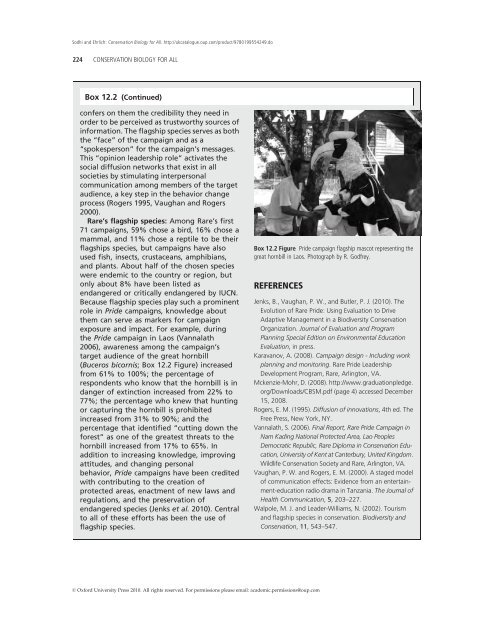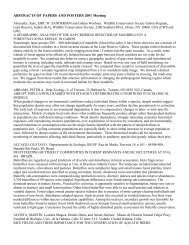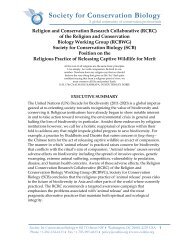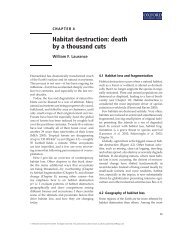Endangered species management: the US experience - Society for ...
Endangered species management: the US experience - Society for ...
Endangered species management: the US experience - Society for ...
You also want an ePaper? Increase the reach of your titles
YUMPU automatically turns print PDFs into web optimized ePapers that Google loves.
Sodhi and Ehrlich: Conservation Biology <strong>for</strong> All. http://ukcatalogue.oup.com/product/9780199554249.do<br />
224 CONSERVATION BIOLOGY FOR ALL<br />
Box 12.2 (Continued)<br />
confers on <strong>the</strong>m <strong>the</strong> credibility <strong>the</strong>y need in<br />
order to be perceived as trustworthy sources of<br />
in<strong>for</strong>mation. The flagship <strong>species</strong> serves as both<br />
<strong>the</strong> “face” of <strong>the</strong> campaign and as a<br />
“spokesperson” <strong>for</strong> <strong>the</strong> campaign’s messages.<br />
This “opinion leadership role” activates <strong>the</strong><br />
social diffusion networks that exist in all<br />
societies by stimulating interpersonal<br />
communication among members of <strong>the</strong> target<br />
audience, a key step in <strong>the</strong> behavior change<br />
process (Rogers 1995, Vaughan and Rogers<br />
2000).<br />
Rare’s flagship <strong>species</strong>: Among Rare’s first<br />
71 campaigns, 59% chose a bird, 16% chose a<br />
mammal, and 11% chose a reptile to be <strong>the</strong>ir<br />
flagships <strong>species</strong>, but campaigns have also<br />
used fish, insects, crustaceans, amphibians,<br />
and plants. About half of <strong>the</strong> chosen <strong>species</strong><br />
were endemic to <strong>the</strong> country or region, but<br />
only about 8% have been listed as<br />
endangered or critically endangered by IUCN.<br />
Because flagship <strong>species</strong> play such a prominent<br />
role in Pride campaigns, knowledge about<br />
<strong>the</strong>m can serve as markers <strong>for</strong> campaign<br />
exposure and impact. For example, during<br />
<strong>the</strong> Pride campaign in Laos (Vannalath<br />
2006), awareness among <strong>the</strong> campaign’s<br />
target audience of <strong>the</strong> great hornbill<br />
(Buceros bicornis; Box 12.2 Figure) increased<br />
from 61% to 100%; <strong>the</strong> percentage of<br />
respondents who know that <strong>the</strong> hornbill is in<br />
danger of extinction increased from 22% to<br />
77%; <strong>the</strong> percentage who knew that hunting<br />
or capturing <strong>the</strong> hornbill is prohibited<br />
increased from 31% to 90%; and <strong>the</strong><br />
percentage that identified “cutting down <strong>the</strong><br />
<strong>for</strong>est” as one of <strong>the</strong> greatest threats to <strong>the</strong><br />
hornbill increased from 17% to 65%. In<br />
addition to increasing knowledge, improving<br />
attitudes, and changing personal<br />
behavior, Pride campaigns have been credited<br />
with contributing to <strong>the</strong> creation of<br />
protected areas, enactment of new laws and<br />
regulations, and <strong>the</strong> preservation of<br />
endangered <strong>species</strong> (Jenks et al. 2010). Central<br />
to all of <strong>the</strong>se ef<strong>for</strong>ts has been <strong>the</strong> use of<br />
flagship <strong>species</strong>.<br />
Box 12.2 Figure Pride campaign flagship mascot representing <strong>the</strong><br />
great hornbill in Laos. Photograph by R. Godfrey.<br />
REFERENCES<br />
Jenks, B., Vaughan, P. W., and Butler, P. J. (2010). The<br />
Evolution of Rare Pride: Using Evaluation to Drive<br />
Adaptive Management in a Biodiversity Conservation<br />
Organization. Journal of Evaluation and Program<br />
Planning Special Edition on Environmental Education<br />
Evaluation, in press.<br />
Karavanov, A. (2008). Campaign design ‐ Including work<br />
planning and monitoring. Rare Pride Leadership<br />
Development Program, Rare, Arlington, VA.<br />
Mckenzie‐Mohr, D. (2008). http://www.graduationpledge.<br />
org/Downloads/CBSM.pdf (page 4) accessed December<br />
15, 2008.<br />
Rogers, E. M. (1995). Diffusion of innovations, 4th ed. The<br />
Free Press, New York, NY.<br />
Vannalath, S. (2006). Final Report, Rare Pride Campaign in<br />
Nam Kading National Protected Area, Lao Peoples<br />
Democratic Republic, Rare Diploma in Conservation Education,<br />
University of Kent at Canterbury, United Kingdom.<br />
Wildlife Conservation <strong>Society</strong> and Rare, Arlington, VA.<br />
Vaughan, P. W. and Rogers, E. M. (2000). A staged model<br />
of communication effects: Evidence from an entertainment‐education<br />
radio drama in Tanzania. The Journal of<br />
Health Communication, 5, 203–227.<br />
Walpole, M. J. and Leader‐Williams, N. (2002). Tourism<br />
and flagship <strong>species</strong> in conservation. Biodiversity and<br />
Conservation, 11, 543–547.<br />
© Ox<strong>for</strong>d University Press 2010. All rights reserved. For permissions please email: academic.permissions@oup.com






